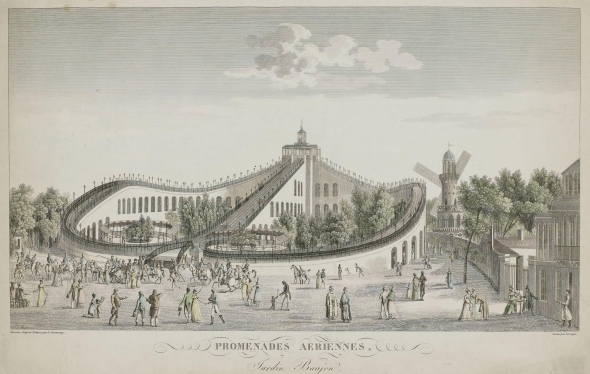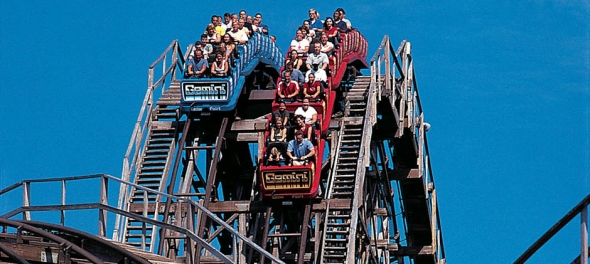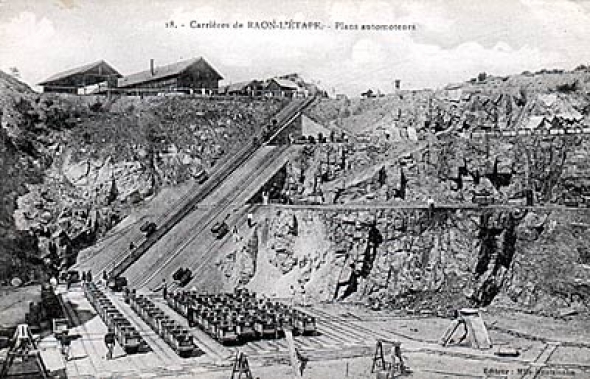The Wheels of Belleville
Image: Wikimedia Commons (license)
Why does France disagree? The honest answer is that they probably want to have a claim to such a historic event. Also, they didn’t have a thrill-seeking granny begging for energy drinks and a daredevil ride experience as their claim of authenticity. In Russia, grandmothers run over reindeer. I now offer my apologies to Yakov Smirnoff haters, whose numbers should be legion.
Anyway, the more diplomatic explanation is that even if Russia did put wheels on a sled first, what they created wasn’t truly a roller coaster in any realistic sense. In 1817, France improved on the premise with a pair of their own inventions.
The first of them, Les Montagnes Russes à Belleville, doesn’t receive as much recognition. Even its name hints at its derivation. It basically translates as The Russian Mountains of Belleville, which sounds like a Sylvain Chomet movie rather than a roller coaster innovation. This is presumably why the French focus on The Promenades Aeriennes in Parc Baujon when they make their claim.
The Promenades Aeriennes featured a symmetrical design that looked almost like the infinity sign. That’s a sideways 8 if you’re not into math. The difference is that rather than a curve in the middle, it had a straight line down the center of the track. Roller coaster enthusiasts are already putting two and two together on this one.
Image: Cedar Fair
Yes, the two tracks operated independently but simultaneously. Yes, it’s a type of ride design still in place today. If you’ve ever been on a coaster like Gemini at Cedar Point, you know the deal. The French version wasn’t quite that polished, as the coaster carts only passed at a single point at the bottom, at which point each one climbed a lift hill. So, there was a bit of a race at the end where the riders could view the adjoining track. That great idea in coaster design you’ve loved since you were a kid is three centuries old.
Amusingly, the better argument for the French inventing the roller coaster is at Les Montagnes Russes à Belleville. It was there that a true advance in coaster design happened. Some enterprising Frenchman had the marvelous idea to tether the cart to the track. Russian Mountains always had a chance for the sled to come off the ground, which any six-year-old will tell you is a lot of the fun. To maximize velocity, however, keeping the cart attached is much better.
The Belleville ride achieved this by slotting grooves into the tracks. Then, it used the axles of the wheels to roll through these grooves. Through this methodology, the coaster cart could maintain its speed while staying under control and following the path. Ride engineers and enthusiasts today know this same strategy by a different term, underfriction. Some ingenious French citizen developed the premise three centuries ago yet they received no recognition for their profound discovery.
USA! USA!
Image: Disney
While all three of roller coaster carts are verifiable and thereby valid claims of a sort, an American still claims the honorary title of Father of the Roller Coaster. His name is LaMarcus Adna Thompson, and he was a wildly successful businessman. In lingerie sales. The history of the roller coaster includes some truly bizarre anecdotes.
Thompson proved at a young age that he owned an inventive mind. When he reached adulthood, he set up shop in Elkhart, Indiana. It was here that he developed an amazing device that could manufacture women’s hosiery without damaging the products. Since hosiery tears so easily, early machines struggled to mass produce nylons. Thompson’s system vastly enhanced the output of products relative to raw materials used. He earned a fortune selling stockings, but years spent in a small manufacturing facility degraded his health. Thompson found himself forced away from the industry that had made him independently wealthy.
With newfound riches and ample free time, Thompson sought a new hobby. He discovered inspiration during a vacation to Pennsylvania. In the eastern portion of the state, he stumbled on a local tourist attraction that would become his obsession. Before we evaluate his impact on the industry, however, the Pennsylvania ride deserves its own discussion.
When is a runaway train called a roller coaster?
Image: Wikimedia Commons (license)
The answer to this riddle is when it’s called the Mauch Chunk Switchback Railway instead. If you’re a coaster enthusiast, you’ve likely heard of this vehicle before. It’s unmistakably the ancestor of the modern roller coaster. The difference is that coasters today don’t include a side of black lung stemming from a ride alongside a ton of coal.
The explanation for the unusual circumstance of a trip down the Mauch Chunk Switchback Railway involves its stated purpose. At first, it was just a train crisscrossing Pisgah Mountain, one of the Appalachian Mountains in that part of Pennsylvania. During the early 19th century, pioneers discovered a massive coal deposit in this region. The problem they faced was how to mine it effectively. Pisgah Mountain has an elevation of 1,557 feet, which is problematic enough in the 21st century. Two hundred years ago, the idea of harvesting those natural resources bordered on impossible.
The Lehigh Coal & Navigation Company embraced this challenge, and the fruits of their labor sustained the company for more than a century. They laid tracks for nine miles of downhill tracks from the summit of Pisgah Mountain to the more serviceable area below. Gravity was their friend in this endeavor. If you put any wheeled vehicle on the top of a hill then give it a push, it’ll slide down at a steadily increasing pace. If you put a ton of coal on the vehicle, it goes much, much faster. You can see where I’m going with this.
The place at the bottom of the mountain, the ultimate destination of all the mined coal, was then known as Mauch Chunk. The workers here spent their days watching a runaway train zoom downhill for 14 kilometers before semi-gracefully stopping in town. The path the train traveled was on rails, so it was safe (ish). The day laborers discovered that they could pass the time in much more entertaining fashion if they hopped a ride from the top of the mountain down to Mauch Chunk. It quickly became the thing to do in town. The locals called it the Gravity Train, and the path it followed was the Gravity Road.
The specs of the train were modest, but the seeds of a roller coaster existed. The Gravity Train became so popular with tourists that an entire line of railway closed for mining purposes. It became a permanent attraction that built up quite the reputation on the East Coast. By the 1850s, guests were willing to pay between 10 and 50 cents to ride, depending on the season and popularity of the Mauch Chunk Switchback Railway. Yes, surge pricing has been around more than 160 years.





Add new comment